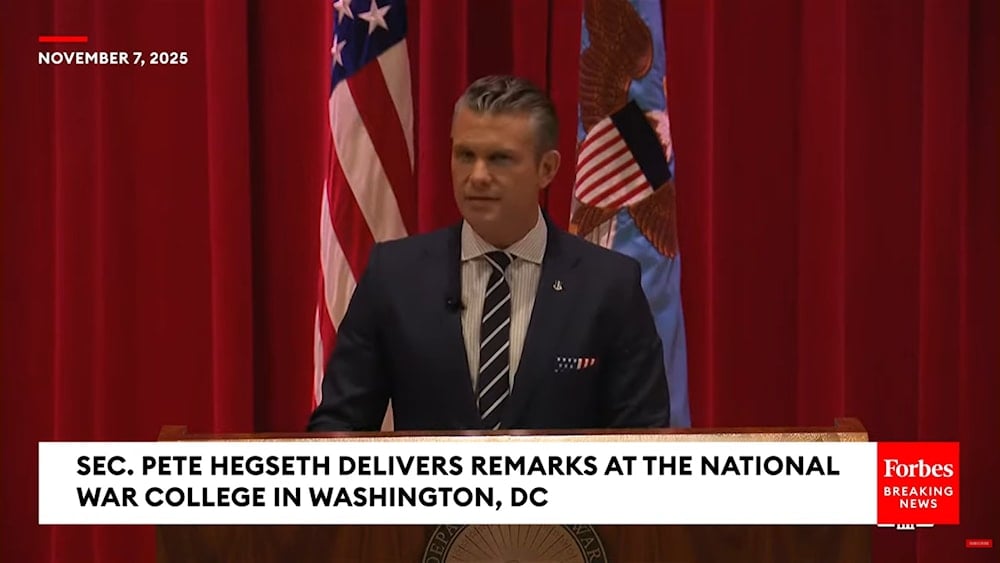US shifts to 'wartime speed' for Golden Dome munitions: Hegseth
The US has begun fast-tracking weapons purchases, including Golden Dome munitions, as Secretary Pete Hegseth unveils a sweeping shift to a wartime-style acquisition system.
-

US Secretary of war Pete Hegseth Delivers Remarks At The National War College In Washington, DC. (Screengrab, YouTube)
The United States is accelerating its weapons procurement efforts, with Secretary of War Pete Hegseth declaring that the Pentagon has begun operating at a pace normally reserved for wartime, particularly in the production of munitions for the Golden Dome missile defense system.
Speaking before senior officers and government officials at the National War College, Hegseth said the department has moved away from its traditional slow-moving processes to address urgent defense needs. "Now we are already moving at wartime speed on both Golden Dome and munitions, working outside the slow bureaucratic process," he told the audience.
"We're not just building a stronger military today. We are laying the foundation for continued dominance in the decades to come," Hegseth said in his address to military leaders and government officials at the National War College.
Is Golden Dome America’s New 'Star Wars'?
Golden Dome is one of Washington’s most ambitious homeland-defense initiatives in decades: a still-developing, multi-layered architecture designed to shield US territory from ballistic, cruise, and hypersonic missiles. The project combines ground-based interceptors with a planned network of space-based sensors and future orbital interceptors, drawing clear inspiration from both "Israel’s" tiered missile security systems and the long-abandoned concepts of the 1980s Strategic Defense Initiative.
Although still in its early phases, Golden Dome has already prompted industry competition involving major defense contractors and new-generation firms, with the administration also exploring potential cooperation with close allies, including Canada, through its existing NORAD framework. Recent months have seen a series of early technical assessments, congressional scrutiny, and debates over cost, feasibility, and timelines as the Pentagon attempts to shape the system’s architecture.
Golden Dome is unlikely to materialize beyond limited prototypes. Similar large-scale missile shield programs, from Reagan’s “Star Wars” initiative to later national missile defense efforts, collapsed under the immense cost and technical impracticality of intercepting diverse threats in real time. The required orbital infrastructure, sensor integration, and interceptor network would demand trillions in sustained investment, an unrealistic prospect given budget constraints, technological limits, and the historical failure of comparable projects to achieve reliable protection.
Experts also say Golden Dome is unlikely to move beyond limited demos, past space-based shield efforts faltered under staggering costs, technical limits, and countermeasures, and the Pentagon’s $175B plan faces higher cost and feasibility doubts.
Acquisition Overhaul
During the same address, Hegseth unveiled a major structural shift in how the Pentagon will acquire weapons and technology, announcing the immediate start of a comprehensive reform of the current procurement model. He argued that the existing framework no longer meets the demands of emerging security challenges.
"Today, at my direction, the Department of War will immediately begin implementing a comprehensive overhaul of our acquisition system," he said. "The defense acquisition system, as you know, is dead. It's now the war-fighting acquisitions system."
The changes mark one of the most aggressive efforts in years to streamline how the US military buys equipment, with officials suggesting that the Pentagon aims to dramatically speed up production cycles amid growing concerns about global rivalry, industrial capacity, and the need to field next-generation defenses far more quickly than traditional acquisition pathways allow.
Hegseth said that Washington’s allies must be equipped with the world’s most advanced weapons to support America’s strategic goals. Speaking at the National War College, Hegseth emphasized that foreign military sales strengthen the US industrial base and ensure partners can operate seamlessly alongside American forces in confronting global threats.
Read more: US to boost drone production to 1Mln to meet future war demand: Report

 4 Min Read
4 Min Read








